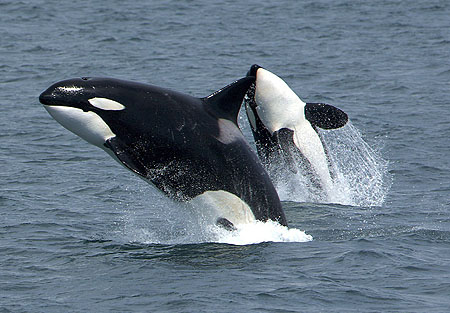Cetacean Assessment and Ecology Program
Killer Whale Surveys in Western Alaska

Figure 1. Two mammal-eating "transient" killer whales photographed off the south side of
Unimak Island, eastern Aleutian Islands, Alaska.
Photo by Robert Pitman (NOAA). |
In June (and July) 2005, the Cetacean Assessment and
Ecology Program (CAEP) conducted killer whale surveys aboard the
chartered fishing vessel Alaskan Enterprise. This comprised part
of the ongoing research by CAEP to determine the distribution,
abundance, stock structure, and diet of killer whales off western
Alaska. The three legs of the 2005 survey focused on: 1) killer whales
in the eastern Aleutian Islands region, 2) killer whales in the central
Aleutian Islands region, and 3) North Pacific right whales in the
southeast Bering Sea.
The focus on right whales was a continuation of a
satellite-tagging project initiated by CAEP during the 2004 Alaska
Cetacean Ecosystem (ACE) survey. A second priority of the 2005 survey
was to collect, when possible, data on humpback whales as a component of
the international North Pacific-wide
SPLASH (Structure of Populations,
Levels of Abundance, and Status of Humpbacks) project.
The main objectives of the killer whale surveys in
2005 were to obtain identification photographs, biopsy samples, and
acoustic recordings of killer whales in order to identify individuals,
document their movements, and examine the stock structure and diet of
killer whales in western Alaska, with a focus on mammal-eating
"transients" (Fig. 1, above). A team of scientists conducted sighting surveys
and took photographs of individual whales while acoustic researchers
deployed sonobuoys (underwater listening devices) to record killer whale
vocalizations. Skin and blubber samples were also collected using remote
biopsy techniques.
During more than 2,500 miles of sighting effort from
31 May to 10 July, there were 36 encounters with killer whales,
including 14 encounters with mammal-eating transient killer whales and
22 encounters with fish-eating "resident" killer whales. Photographs
collected during these encounters will be examined to determine the
total number of individual whales observed and will contribute to
mark-recapture estimates of abundance and movements. Thirty-four tissue
samples collected from 19 transient and 15 resident killer whales will
be analyzed to determine stock identity, assess contaminant levels, and
infer dietary preferences. Biopsy samples were also collected from
potential killer whale prey species for a fatty-acid diet analysis and
for genetics studies. Humpback whale photographs and biopsy samples (16)
were collected for the SPLASH project.
Observed instances of predation/harassment by
mammal-eating killer whales included a group of transients feeding on a
gray whale carcass on the south side of Unimak Island, in the eastern
Aleutian Islands; two groups of transients harassing a gray whale
mother/calf pair near the shore on the north side of Unimak Island; and
a group of transients attacking and killing a northern fur seal near the
Pribilof Islands in the southeast Bering Sea.
Sightings of more than 900 marine mammals during the
cruise included the following species and number of encounters: killer
whales (36), Pacific white-sided dolphins (2), harbor porpoise (46),
gray whales (29), Dallís porpoise (138), sperm whales (68), Bairdís
beaked whales (3), minke whales (102), fin whales (54), humpback whales
(93), sea otters (65), Steller sea lions (13), and northern fur seals (130).
By John Durban
>>>continued
 |

|
Quarterly sidebar
AFSC Quarterly Research Reports April-June 2005
Contents
Feature
ABL Reports
NMML Reports
RACE Reports
REFM Reports
Items
Quarterly Index
Quarterly Home
|

